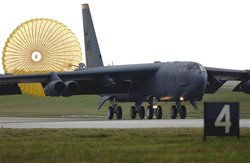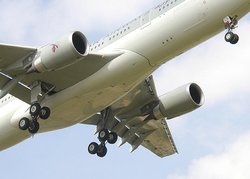Undercarriage
|
|
Missing image Undercarriage.b747.arp.jpg Wing and fuselage undercarriages on a Boeing 747, shortly before landing |
 The dual tandem landing gear of a B-52 Stratofortress |
The undercarriage or landing gear is equipment which supports an aircraft when it is not flying. The assembly usually has wheels and some sort of shock absorber apparatus, but sometimes skis for snow or floats for water, and skids or pontoons (helicopters). To decrease drag in flight, the undercarriages on many aircraft, particularly large modern ones, retract behind doors which close flush with the fuselage. This was invented by the Frenchmen Penaud and Gauchot in 1876.
Wheeled undercarriages come in two main types: either taildragger, where there are two main wheels towards the front of the aircraft and a single, much smaller, wheel or skid at the rear; or tricycle undercarriage where there are two main wheels (or wheel assemblies) under the wings and a third smaller wheel in the nose. Most modern airplanes have tricycle undercarriages or variants thereof. Taildraggers are considered harder to land and take off, and usually require special training. Sometimes a small tail wheel or skid is added to aircraft with tricycle undercarriage, in case the tail strikes the ground during take-off. The Concorde, for instance, had a retractable tail "bumper" wheel.
As aircraft grow larger, they employ more wheels to cope with the increasing weights. The Airbus A340-500 has an additional four-wheel undercarriage bogie on the fuselage centreline. The Boeing 747 has five sets of wheels, a nose-wheel assembly and two sets of four-wheel bogies under under each wing.Tricycle undercarriage aircraft are usually steered by the leading wheel(s) when taxying. The Boeing 747 is also steered by the two inside under-wing bogies. When the nose wheels are guiding the front of the 747 to the right, the inner under-wing wheels are steering the body of the aircraft left (much as four-wheel steering works on a car).
Some planes use wheels only for take off and drop them afterwards to gain the improved streamlining without the complexity, weight and space requirements of a retraction mechanism. In this case, landing is achieved on skids or similar simple devices. Historical examples include the Messerschmitt Me 163 and the Messerschmitt Me 321.
Other examples of unusual undercarriage configuration include the Hawker Harrier, which has two mainwheels in line under the fuselage (called a tandem layout) and a smaller wheel near the tip of each wing (moved further inboard on second generation Harriers). A variation of the tandem layout is also used on the B-52 Stratofortress which has four main wheels underneath the fuselage and a small wheel supporting each wingtip. The B-52's landing gear is also unique in the way all four main wheels can be steered. This allows the landing gear to line up with the runway and thus makes crosswind landings easier (using a technique called crab landing).
Undercarriage malfunction can directly result in ground loop.
Undercarriage is also a euphemism for human genitals.de:Fahrwerk (Flugzeug) nl:Landingsgestel pl:Podwozie (lotnictwo) pt:Trem de pouso

